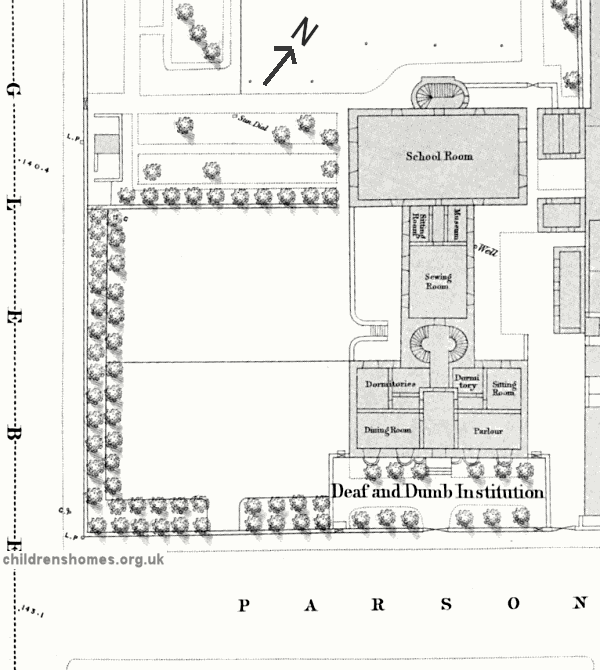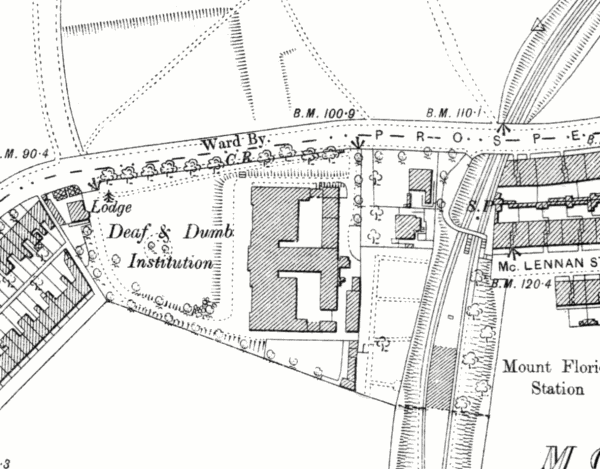Glasgow Deaf and Dumb Institution, Glasgow, Lanarkshire, Scotland
In 1814, the head of the Edinburgh Institution for the Deaf and Dumb, Robert Kinniburgh, took some of his pupils to Glasgow to demonstrate his methods of teaching and their results. The enthusiasm that this generated resulted in the formation of the Glasgow Auxiliary Society, which raised funds to send poor children from Glasgow to the Edinburgh Institution. In January 1819, a shortage of places at Edinburgh led to the formation of the Glasgow Society for the Education of the Deaf and Dumb, which subsequently opened its own establishment — the Glasgow Institution for the Deaf and Dumb.
The person appointed to run the Institution was John Anderson, who had been running a school for the deaf in the city since 1816. Fund-raising quickly raised enough for the purchase of a site on the Barony Glebe, at the corner of Glebe Street and Parson Street, Glasgow. In March 1820, the foundation stone was laid for the new building with its entrance at what was to become known as 38 Parson Street. It was ready for occupation later that year. In the interim, Anderson continued to teach in his house at 38 John Street. The Parson Street site is shown on the 1857 map below.

Glasgow Deaf and Dumb Institution site, Glasgow, c.1857.
In November 1820, forty-seven pupils were enrolled at the establishment. By 1836, the number had increased, to 68 and an extension was urgently required. In 1838, a new schoolroom and sleeping accommodation for an additional thirty children was added. To pay for the £2,000 cost the work, a special subscription list was opened. However, the Institution remained in debt until 1841, when Glasgow Town Council donated £200 to help clear this off. In 1845, a 'Thanksgiving Fund' was launched, which placed the institution on an even footing. From 1846, it also received a useful annual donation in the form of 100 carts of coal from local coal owners.
I 1822, the pupils' day began at 7 a.m., with the girls doing housework and the boys gardening until 9 a. m. when breakfast was served. School work occupied from 10 a.m. until 4 p.m., after which there was dinner, followed by more domestic work and gardening until 6 p. m.
Other forms of occupational training were soon introduced. A printing press was donated to the institution and some of the older boys were instructed in its use. Instruction was also provided in a number of 'ordinary trades', presumably those such as shoemaking, tailoring and carpentry. At the same time, the girls were being given instruction in needlework and 'household duties'.
In 1832, Duncan Anderson took charge of the institution and introduced a number of innovations. The school gardens were laid out as a botanical garden, a museum was formed, and many useful drawings and illustrations produced. He also co-authored a widely used book “Graduated Lessons in Language and Grammar: for the Instruction of the Deaf and Dumb.” This introduced a classified vocabulary then went on to illustrate the uses of various parts of speech — adjectives, pronouns, and verbs. The various combinations of the parts of speech already learned were then illustrated with sentences and questions. At first, Anderson was a keen teacher of speech but apparently later adopted writing, finger-spelling, and signs as his preferred method of teaching.
By 1839, The Society's Directors had decided to replace trade training by a scheme in which the older pupils were apprenticed to local tradesmen. During the period of their apprenticeship they were given an allowance from the institution of two shillings a week. The trades to which the pupils were apprenticed under this scheme included those of shoemaker, tailor, weaver, dressmaker, and umbrella-maker.
Demand for places at the school continued to grow and four or five rooms were added to the existing premises in 1858. Two years later plans were drawn up for a new school in the country, as the Barony Glebe site had become surrounded by tall buildings, and the suffered from the noxious fumes emitted by surrounding businesses. Eventually, in 1865. a sub-committee was formed to raise funds and sell the old school when the new one was completed. A three-acre site was found at Prospecthill Road, Langside, and the foundation stone of the new school was laid on 20 October 20 1864. The building, designed by James Salmon, was fitted out for 150 inmates, whereas the old premises could not house more than 80 or 90. The official opening, by the Lord Provost, took place on 22 May 1868. A contemporary report described the new institution as:

Glasgow Deaf and Dumb Institution site, Glasgow, c.1893.

Glasgow Deaf and Dumb Institution, Glasgow, c.1868. © Peter Higginbotham
In 1890, the admission procedure for the institution was:

Glasgow Deaf and Dumb Institution, Glasgow, early 1900s.
Pupils at the school learned Scottish dancing and some of them gave demonstrations of local events. The picture below shows three girls named (left to right) Mary Jamieson, Mary Allison and Mary Pratt, performing in 1904.

Dancers from Glasgow Deaf and Dumb Institution, Glasgow, early 1900s. © Peter Higginbotham.
In 1918, the rising costs of maintenance at the Institution during the war years had led the Directors of the Society to consider whether it might not be better for the children attending the institution if the latter gave up its independence and moved to local authority control. Additional pressure for such a change came in the 1918 Education Act raised the school leaving age from 12 to 14. Accordingly, in 1919, the Directors began negotiations with the Glasgow Education Authority in 1919, with a view to the ultimate transfer of the Institution to the authority. On 31 May 1920, the Authority took over the school and other buildings at Langside. The establishment then became known as the Langside School for the Deaf.
This was not the end of the Society, however. In 1921, it was formally reconstituted and continued in operation but now focussing on welfare rather than education. In 1922, it appointed an 'After-care Educational Supervisor' to carry out regular visits to pupils leaving the school. Selected boys and girls over the age of 16 were given advanced technical and domestic training at the institution. In 1932, the the Society supported the opening of a 'Shoecraft Repair Salon' in Glasgow, under the auspices of the Scottish Association for the Deaf. Although it proved not to be self-supporting, it provided useful training to young deaf boys in modern methods of boot and shoe repair. A Horticultural and Market Gardening Scheme, started by the Kilmarnock Mission in 1934, was also supported by the Society, as were the Fairyhill Nursery Association Ltd.
Following being taken over by the Education Authority, the number of pupils attending the school, which had fallen to 140 in 1921, dropped to 55 in 1930. The reason for the decrease was that the Authority charged bodies using the school the full cost of pupils' maintenance, part of which had previously bee subsidised by the Society. Many authorities in the West of Scotland, notably in Ayrshire, stopped sending their children to Langside and sent them instead to the Edinburgh Deaf Asylum, which had much lower charges for board.
During the Second World War, the School was evacuated to Dailly. When it returned in 1946, the Langside buildings were found to be uninhabitable and the School was accommodated at Gilsochhill in the district of Maryhill. In 1945, negotiations were begun for the School with the St Vincent's Roman Catholic Institution for the Deaf and Dumb and Blind at Tollcross. In 1947, the Glasgow Education Committee became responsible for the whole school.
The Langside building subsequently became home to Langside College. It has now been converted to flats, known as the Chroma building.
Records
Note: many repositories impose a closure period of up to 100 years for records identifying individuals. Before travelling a long distance, always check that the records you want to consult will be available.
- None identfied at present — any information welcome.
Census
Bibliography
- Higginbotham, Peter Children's Homes: A History of Institutional Care for Britain's Young (2017, Pen & Sword)
- Pritchard, D.G., Education and the Handicapped 1760-1960 (1963, Routledge & Kegan Paul)
- Watson, J, Instruction of the Deaf and Dumb (1809)
- Watson, Thomas J., A History of Deaf Education in Scotland 1760-1939 (Unpublished PhD Thesis, University of Edinburgh, 1949)
Links
Except where indicated, this page () © Peter Higginbotham. Contents may not be reproduced without permission.


